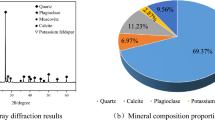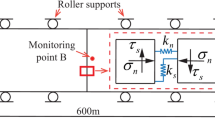Abstract
To investigate the effect of freeze–thaw cycles on sandstone's internal fracture development and damage evolution by analyzing the mechanical properties, energy evolution, and acoustic emission (AE) parameters of sandstone subjected to 0, 30, 50, and 70 freeze–thaw cycles. The results revealed that freeze–thaw cycles cause a decrease in the peak strength, elastic modulus, and brittleness of the sandstone. In contrast, the initial axial strain first decreases but eventually increases with an increasing number of freeze–thaw cycles. Throughout the freeze–thaw cycle, there is a reduction in both the total and elastic energy and their growth rates. Due to the impact of freeze–thaw cycles, secondary fractures occur in sandstone, ultimately leading to amplified dissipated energy during the compaction stage. The AE signal activity increases as the internal damage of the sandstone intensifies, and the active period advances with the number of freeze–thaw cycles. As the number of freeze–thaw cycles increases, when the rock is damaged by load, the second increase of the dissipated-elastic energy ratio K-value is delayed, and the step-down of the b-value is advanced. The failure mode of sandstone changes from shear failure to tensile failure. Ultimately, the uniaxial compressive strength of freeze–thaw sandstone follows an exponential decay model, which can be used to predict the strength of freeze–thaw sandstone. The high-frequency and high-amplitude AE signal, the second increase in the K-value, and the step-like decrease in the b-value can be used as reliable indicators of the fracture and instability of freeze-thawed sandstone.








Similar content being viewed by others
Data availability
All data generated or analyzed during this study are included within the article.
References
Du K, Li XF, Tao M, Wang SF (2020) Experimental study on acoustic emission (AE) characteristics and crack classification during rock fracture in several basic lab tests. Int J Rock Mech Min 133:104411. https://doi.org/10.1016/j.ijrmms.2020.104411
Eltaher MA, Alsulami R, Wagih A (2021) On the evolution of energy dissipation in dispersed composite laminates under out-of-plane loading. Compos Part B-Eng 216:108864. https://doi.org/10.1016/j.compositesb.2021.108864
Gao F, Xiong X, Xu CS, Zhou KP (2021) Mechanical property deterioration characteristics and a new constitutive model for rocks subjected to freeze-thaw weathering process. Int J Rock Mech Min 140:104642. https://doi.org/10.1016/j.ijrmms.2021.104642
Han ZY, Li DY, Zhou T, Zhu QQ, Ranjith PG (2020) Experimental study of stress wave propagation and energy characteristics across rock specimens containing cemented mortar joint with various thicknesses. Int J Rock Mech Min 131:104352. https://doi.org/10.1016/j.ijrmms.2020.104352
Hao XJ, Wei YN, Yang K, Su J, Sun YF, Zhu GP, Wang SH, Chen HB, Sun ZW (2021) Anisotropy of crack initiation strength and damage strength of coal reservoirs. Petrol Explor Develop 48:243–255. https://doi.org/10.1016/S1876-3804(21)60020-4
Hou YQ, Yin SH, Chen X, Zhang MZ, Yang SX (2021) Study on characteristic stress and energy damage evolution mechanism of cemented tailings backfill under uniaxial compression. Constr Build Mater 301:124333. https://doi.org/10.1016/j.conbuildmat.2021.124333
Huang SB, He YB, Liu XW, Xin ZK (2021) Experimental investigation of the influence of dry-wet, freeze-thaw and water immersion treatments on the mechanical strength of the clay-bearing green sandstone. Int J Rock Mech Min 138:104613. https://doi.org/10.1016/j.ijrmms.2021.104613
Jamshidi A, Nikudel MR, Khamehchiyan M (2016) Evaluation of the durability of Gerdoee travertine after freeze–thaw cycles in fresh water and sodium sulfate solution by decay function models. Eng Geol 202:36–43. https://doi.org/10.1016/j.enggeo.2016.01.004
Lai XP, Fang XW, Shan PF, Cui F, Chen JQ, Zhang S, Liu XD (2021) Failure mode and phased energy accumulation and release law of brittle holey coal samples during loading. J Min Saf Eng 38:1005–1014. https://doi.org/10.13545/j.cnki.jmse.2021.0136
Luo Y, Wang G, Li XP, Liu TT, Mandal AK, Xu MN, Xu K (2020) Analysis of energy dissipation and crack evolution law of sandstone under impact load. Int J Rock Mech Min 132:104359. https://doi.org/10.1016/j.ijrmms.2020.104359
Ma LQ, Sun H, Ngo L, Han J (2022) Infrared radiation quantification of rock damage and its constitutive modeling under loading. Infrared Phys Techn 121:104044. https://doi.org/10.1016/j.infrared.2022.104044
Mareau C, Cuillerier D, Morel F (2013) Experimental and numerical study of the evolution of stored and dissipated energies in a medium carbon steel under cyclic loading. Mech Mater 60:93–106. https://doi.org/10.1016/j.mechmat.2013.01.011
Niu CY, Zhu ZM, Zhou L, Li XH, Ying P, Dong YQ, Deng S (2021) Study on the microscopic damage evolution and dynamic fracture properties of sandstone under freeze-thaw cycles. Cold Reg Sci Technol 191:103328. https://doi.org/10.1016/j.coldregions.2021.103328
Sagasta F, Zitto ME, Piotrkowski R, Benavent-Climent A, Suarez E, Gallego A (2018) Acoustic emission energy b-value for local damage evaluation in reinforced concrete structures subjected to seismic loadings. Mech Syst Signal Pr 102:262–277. https://doi.org/10.1016/j.ymssp.2017.09.022
Sharifzadeh M, Lou JF, Crompton B (2020) Dynamic performance of energy-absorbing rockbolts based on laboratory test results. Part I: Evolution, deformation mechanisms, dynamic performance and classification. Tunn Undergr Sp Tech 105:103510. https://doi.org/10.1016/j.tust.2020.103510
Shi HC (2020) Creep acoustic emission and fractal characteristics of coal rock under high temperature pre-damage. Coal Geol Explor 48:187–194. https://doi.org/10.3969/j.issn.1001-1986.2020.02.028
Su ZZ, Tan XJ, Chen WZ, Jia HL, Xu F (2021) A model of unfrozen water content in rock during freezing and thawing with experimental validation by nuclear magnetic resonance. J Rock Mech Geotech Eng 14:1545–1555. https://doi.org/10.1016/j.jrmge.2021.10.009
Wang CY, Chang XK, Liu YL, Chen SJ (2019a) Mechanistic characteristics of double dominant frequencies of acoustic emission signals in the entire fracture process of fine sandstone. Energies 12:3959. https://doi.org/10.3390/en12203959
Wang GL, Wang RQ, Sun F, Liu BL, Zhang L, Cao YC, Li BY (2022a) Analysis of nonlinear energy evolution in fractured limestone under uniaxial compression. Theor Appl Fract Mec 120:103387. https://doi.org/10.1016/j.tafmec.2022.103387
Wang J, Li JT, Shi ZM, Chen JC (2022b) Energy evolution and failure characteristics of red sandstone under discontinuous multilevel fatigue loading. Int J Fatigue 160:106830. https://doi.org/10.1016/j.ijfatigue.2022.106830
Wang LP, Li N, Qi JL, Tian YZ, Xu SH (2019b) A study on the physical index change and triaxial compression test of intact hard rock subjected to freeze-thaw cycles. Cold Reg Sci Technol 160:39–47. https://doi.org/10.1016/j.coldregions.2019.01.001
Wang Y, Gao SH, Li CH, Han JQ (2020) Investigation on fracture behaviors and damage evolution modeling of freeze-thawed marble subjected to increasing- amplitude cyclic loads. Theor Appl Fract Mec 109:102679. https://doi.org/10.1016/j.tafmec.2020.102679
Wu C, Gong FQ, Luo Y (2021) A new quantitative method to identify the crack damage stress of rock using AE detection parameters. B Eng Geol Environ 80:519–531. https://doi.org/10.1007/s10064-020-01932-6
Xie HZ, Yang LY, Zhang QH, Huang C, Chen MX, Zhao KP (2022) Research on energy dissipation and damage evolution of dynamic splitting failure of basalt fiber reinforced concrete. Constr Buil Mater 330:127292. https://doi.org/10.1016/j.conbuildmat.2022.127292
Yang J, Mu ZL, Yang SQ (2020) Experimental study of acoustic emission multi-parameter information characterizing rock crack development. Eng Fract Mech 232:107045. https://doi.org/10.1016/j.engfracmech.2020.107045
Zafar S, Hedayat A, Moradian O (2022) Evolution of tensile and shear cracking in crystalline rocks under compression. Theor Appl Fract Mec 118:103254. https://doi.org/10.1016/j.tafmec.2022.103254
Zhang HM, Meng XZ, Yang GS (2020) A study on mechanical properties and damage model of rock subjected to freeze-thaw cycles and confining pressure. Cold Reg Sci Technol 174:103556. https://doi.org/10.1016/j.coldregions.2020.103056
Zhang LM, Cong Y, Meng FZ, Wang ZQ, Zhang P, Gao S (2021a) Energy evolution analysis and failure criteria for rock under different stress paths. Acta Geotech 16:569–580. https://doi.org/10.1007/s11440-020-01028-1
Zhang Y, Li BB, Xu J, Gao Z, Chen S, Wang B (2021b) Study on triaxial compression damage evolution characteristics of coal based on energy dissipation. Chinese J Rock Mech Eng 40:1614–1627. https://doi.org/10.13722/j.cnki.jrme.2020.1133
Zhang ZB, Liu XN, Zhang YH, Qin XY, Khan M (2021c) Comparative study on fracture characteristics of coal and rock samples based on acoustic emission technology. Theor Appl Fract Mec 111:102851. https://doi.org/10.1016/j.tafmec.2020.102851
Zhao K, Yang DX, Gong C, Zhuo YL, Wang XJ, Zhong W (2020) Evaluation of internal microcrack evolution in red sandstone based on time–frequency domain characteristics of acoustic emission signals. Constr Build Mater 260:120435. https://doi.org/10.1016/j.conbuildmat.2020.120435
Zhu XY, Chen XD, Bai Y, Ning YJ, Zhang W (2022) Evaluation of fracture behavior of high-strength hydraulic concrete damaged by freeze-thaw cycle test. Constr Build Mater 321:1246. https://doi.org/10.1016/j.conbuildmat.2022.126346
Acknowledgements
The authors gratefully acknowledge the financial support offered by the Young Talents of Science and Technology in Universities of Inner Mongolia Autonomous Region (NJYT22073); Inner Mongolia Natural Science Foundation (2022MS05037).
Author information
Authors and Affiliations
Corresponding author
Ethics declarations
Conflict of interest
The authors declare that there is no conflict of interest regarding the publication of this paper.
Additional information
Publisher's Note
Springer Nature remains neutral with regard to jurisdictional claims in published maps and institutional affiliations.
Rights and permissions
Springer Nature or its licensor (e.g. a society or other partner) holds exclusive rights to this article under a publishing agreement with the author(s) or other rightsholder(s); author self-archiving of the accepted manuscript version of this article is solely governed by the terms of such publishing agreement and applicable law.
About this article
Cite this article
Wang, C., You, R. & Han, T. Experimental Study on Sandstone Fracture and Damage Evolution Law Under Freeze–Thaw Cycles. Geotech Geol Eng 41, 2923–2937 (2023). https://doi.org/10.1007/s10706-023-02437-1
Received:
Accepted:
Published:
Issue Date:
DOI: https://doi.org/10.1007/s10706-023-02437-1




